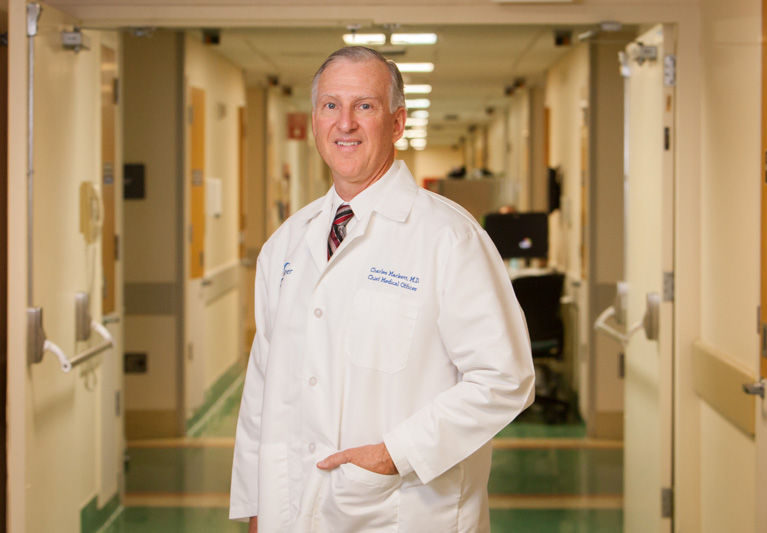
If you thought Methicillin-Resistant Staphylococcus Aureus or MRSA infections were scary, wait until you meet carbapenem-resistant Enterobacteriaceae, commonly called CRE, a family of mutant bacteria that kill half of those infected.
New strains of antibiotic-resistant bacteria are continuing to emerge across the globe and Vero Beach is definitely not immune to these new “super-duper bugs” trying to settle in and call this place home.
Both Dr. Charles Mackett III, senior vice president and medical director at Indian River Medical Center and Diane Bain, RN, infection preventionist, have recently come face to face with CRE, the latest super bug to make worldwide headlines and they’re not about to lay out a welcome mat for this infectious killer.
The Centers for Disease Control and Prevention just named CRE, “One of the most urgent threats among emerging forms of antibiotic-resistant diseases.” The CDC also reports that CRE has been diagnosed in 47 of 50 states and has infected over two million Americans. It now kills approximately 23,000 people each year.
Common CRE bacteria species include Klebsiella and Escherichia coli (E. coli). These bactirium are found in normal human intestinal tracts but when they spread to other areas of the body in their mutated form, they can cause serious and life-threatening problems including urinary tract infections, bloodstream infections, wound infections and pneumonia.
The CDC says up to half of those whose bloodstream is infected will die. But like the zombies so popular on prime time television and movies these days, CRE itself is incredibly difficult to kill.
That’s because CRE has developed a high – and sometimes absolute – level of resistance to most modern antibiotics.
Bacteria may be small but they aren’t dumb. Long before the pharaohs built their pyramids or Chinese emperor Qin Shi Huang started building his great wall, people have been trying to kill bacteria using honey, assorted tree barks and a host of herbal compounds. Centuries later, in 1923, when Alexander Fleming stumbled onto penicillin, mankind thought it had finally won this war.
Mankind was wrong.
Bacteria evolved, mutated and adapted as antibiotic use increased. Now these microorganisms are resisting our efforts to kill them on an entirely new level as Deverick Anderson, an associate professor at Duke Medicine explained to USA Today. “We’re trying to sound the alarm,” says Anderson. “This is a problem for all of us in healthcare. These [bacteria] are just about as bad as it gets.”
It is not, however, time to panic, according to Mackett.
Some of the initial television reports on CRE, for example, linked these infections almost exclusively to the use of endoscopes and duodenoscopes in various gastroenterological procedures at the Ronald Reagan Medical Center on the campus of UCLA in California. It turns out TV got it wrong.
The scopes are hard to clean and do sometimes spread deadly bacteria, as they did in California, but the Centers for Disease Control and Prevention now says, “CRE germs are usually spread person-to-person . . . particularly via contact with wounds or stool.”
The CDC goes on to say, “Healthy people usually don’t get CRE infections” and that, “CREs are more likely to affect those patients who have compromised immune systems.” That’s why hospitals and long term care facilities appear to be the sources for so many CRE infections.
Moreover, while Mackett’s team at IRMC has been dealing with a critical case of CRE involving a Vero Beach man, the hospital also just went through Medicare’s Joint Commission Accreditation inspection and, according to Mackett, passed with flying colors.
The Joint Commission report says IRMC “rarely” has a CRE infection and, Mackett adds, the current case is the only one the hospital has seen in a year.
That’s an infinitely better track record than the two Florida hospitals in Highlands County where Bloomberg News reports 70 people were infected by CRE and 15 died, or the hospital in Charlotte County where another 22 people were infected.
That’s not to say IRMC isn’t taking additional steps to prevent CRE infections. Infection preventionist Bain explains that not only does the hospital strictly follow the manufacturer’s 55-step guidelines for cleaning and disinfecting duodenoscopes, it has added additional steps of its own. After a through manual cleaning, says Bain, “We use a Medivator automated machine” for further cleansing along with, “a paracetic acid-based solution.” IRMC, she boasts, also takes random culture samples and, “If someone [a scope is used on] is sick,” she continues, “that process is repeated three (more) times.”
Mackett and many other microbiologists place part of the blame for these more virulent strains of antibiotic-resistant bacteria on society at large and the general over-use of antibiotics. “Sometimes,” Market explains, “the public demands antibiotics even when they’re not really necessary.”
The more antibiotic products like dishwashing detergents, window cleaners, garbage bags and such that are out there, the faster all forms of bacteria can and will adapt and resist.
In the meantime, Mackett says everyone can chip in and help fight CRE. “I encourage people to be proactive in their own care,” says the IRMC medical director.
Being proactive in a hospital setting includes making sure caregivers always wash and sanitize their hands when they enter your room and do so again when they leave. Taking antibiotics only when prescribed and always finishing the entire course is another way to fight back; always washing and sanitizing your hands after a bowel movement is also highly recommended.
CRE isn’t really a “super-duper bug.” It is a downright deadly nightmare bug. Still, like previous generations of bacterial infections, it can usually be kept in check when proper procedures and common sense are employed, and Vero residents can take some comfort from IRMC’s success in controlling the bacteria.



